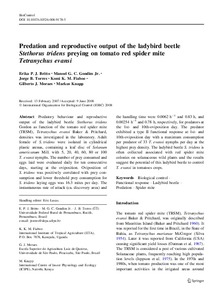| dc.contributor.author | Britto, E.P. |
| dc.contributor.author | Gondim, M.G. |
| dc.contributor.author | Torres, J.B. |
| dc.contributor.author | Fiaboe, K.K.M. |
| dc.contributor.author | Moraes, G.J. |
| dc.contributor.author | Knapp, M. |
| dc.date.accessioned | 2019-12-04T11:15:05Z |
| dc.date.available | 2019-12-04T11:15:05Z |
| dc.date.issued | 2008 |
| dc.identifier.citation | Britto, E.P., Gondim, M.G., Torres, J.B., Fiaboe, K.K., Moraes, G.J. & Knapp, M. (2009). Predation and reproductive output of the ladybird beetle Stethorus tridens preying on tomato red spider mite Tetranychus evansi. Biological Control, 54(3), 363-368. |
| dc.identifier.issn | 1386-6141 |
| dc.identifier.uri | https://hdl.handle.net/20.500.12478/2914 |
| dc.description.abstract | Predatory behaviour and reproductive
output of the ladybird beetle Stethorus tridens
Gordon as function of the tomato red spider mite
(TRSM), Tetranychus evansi Baker & Pritchard,
densities was investigated in the laboratory. Adult
female of S. tridens were isolated in cylindrical
plastic arenas, containing a leaf disc of Solanum
americanum Mill. with 5, 20, 40, 60, 80 or 100
T. evansi nymphs. The number of prey consumed and
eggs laid were evaluated daily for ten consecutive
days, starting at the oviposition. Oviposition of
S. tridens was positively correlated with prey consumption
and lower threshold prey consumption for
S. tridens laying eggs was 16.3 mites per day. The
instantaneous rate of attack (ca. discovery area) and
the handling time were 0.0062 h-1 and 0.83 h, and
0.00254 h-1 and 0.78 h, respectively, for predators at
the 1st- and 10th-oviposition day. The predator
exhibited a type II functional response at 1st- and
10th-oviposition day with a maximum consumption
per predator of 33 T. evansi nymphs per day at the
highest prey density. The ladybird beetle S. tridens is
often collected associated with red spider mite
colonies on solanaceous wild plants and the results
suggest the potential of this ladybird beetle to control
T. evansi in tomatoes crops. |
| dc.description.sponsorship | Federal Ministry for Economic Cooperation and Development, Germany |
| dc.language.iso | en |
| dc.subject | Biological Control |
| dc.subject | Functional Response |
| dc.subject | Ladybird Beetle |
| dc.subject | Predation |
| dc.subject | Spider Mite |
| dc.subject | Tetranychus Evansi Nymphs |
| dc.title | Predation and reproductive output of the ladybird beetle Stethorus tridens preying on tomato red spider mite Tetranychus evansi |
| dc.type | Journal Article |
| dc.description.version | Peer Review |
| cg.contributor.affiliation | Universidade Federal Rural de Pernambuco |
| cg.contributor.affiliation | International Institute of Tropical Agriculture |
| cg.contributor.affiliation | Universidade de São Paulo |
| cg.contributor.affiliation | International Centre of Insect Physiology and Ecology |
| cg.coverage.region | Acp |
| cg.coverage.region | Africa |
| cg.coverage.region | South America |
| cg.coverage.region | East Africa |
| cg.coverage.country | Brazil |
| cg.coverage.country | Uganda |
| cg.coverage.country | Kenya |
| cg.isijournal | ISI Journal |
| cg.authorship.types | CGIAR and developing country institute |
| cg.iitasubject | Plant Production |
| cg.iitasubject | Plant Health |
| cg.iitasubject | Plant Diseases |
| cg.iitasubject | Post-Harvesting Technology |
| cg.iitasubject | Plant Ecology |
| cg.iitasubject | Pests Of Plants |
| cg.iitasubject | Markets |
| cg.iitasubject | Disease Control |
| cg.accessibilitystatus | Limited Access |
| local.dspaceid | 94015 |
| cg.identifier.doi | https://dx.doi.org/10.1007/s10526-008-9178-5 |

